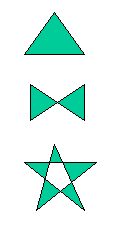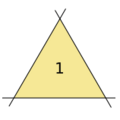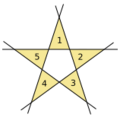Kobon triangle problem
| Unsolved problem in mathematics: How many non-overlapping triangles can be formed in an arrangement of [math]\displaystyle{ k }[/math] lines? (more unsolved problems in mathematics)
|
The Kobon triangle problem is an unsolved problem in combinatorial geometry first stated by Kobon Fujimura (1903-1983). The problem asks for the largest number N(k) of nonoverlapping triangles whose sides lie on an arrangement of k lines. Variations of the problem consider the projective plane rather than the Euclidean plane, and require that the triangles not be crossed by any other lines of the arrangement.[1]
Known upper bounds
Saburo Tamura proved that the number of nonoverlapping triangles realizable by [math]\displaystyle{ k }[/math] lines is at most [math]\displaystyle{ \lfloor k(k-2)/3\rfloor }[/math]. G. Clément and J. Bader proved more strongly that this bound cannot be achieved when [math]\displaystyle{ k }[/math] is congruent to 0 or 2 (mod 6).[2] The maximum number of triangles is therefore at most one less in these cases. The same bounds can be equivalently stated, without use of the floor function, as: [math]\displaystyle{ \begin{cases} \frac 13 k (k-2) & \text{when } k \equiv 3,5 \pmod{6}; \\ \frac 13 (k+1)(k-3) & \text{when } k \equiv 0,2 \pmod{6}; \\ \frac 13 (k^2-2k-2) & \text{when } k \equiv 1,4 \pmod{6}. \end{cases} }[/math]
Solutions yielding this number of triangles are known when [math]\displaystyle{ k }[/math] is 3, 4, 5, 6, 7, 8, 9, 13, 15 or 17.[3] For k = 10, 11 and 12, the best solutions known reach a number of triangles one less than the upper bound.
Known constructions
Given an optimal solution with k0 > 3 lines, other Kobon triangle solution numbers can be found for all ki-values where [math]\displaystyle{ k_{n+1} = 2\cdot k_{n} - 1, }[/math] by using the procedure by D. Forge and J. L. Ramirez Alfonsin.[1] For example, the solution for k0 = 5 leads to the maximal number of nonoverlapping triangles for k = 5, 9, 17, 33, 65, ....[failed verification]
| k | 3 | 4 | 5 | 6 | 7 | 8 | 9 | 10 | 11 | 12 | 13 | 14 | 15 | 16 | 17 | 18 | 19 | 20 | 21 | OEIS |
| Tamura's upper bound on N(k) | 1 | 2 | 5 | 8 | 11 | 16 | 21 | 26 | 33 | 40 | 47 | 56 | 65 | 74 | 85 | 96 | 107 | 120 | 133 | A032765 |
| Clément and Bader's upper bound | 1 | 2 | 5 | 7 | 11 | 15 | 21 | 26 | 33 | 39 | 47 | 55 | 65 | 74 | 85 | 95 | 107 | 119 | 133 | - |
| best known solution | 1 | 2 | 5 | 7 | 11 | 15 | 21 | 25 | 32 | 38 | 47 | 53 | 65 | 72 | 85 | 93 | 104 | 115 | 130 | A006066 |
Examples
See also
- Roberts's triangle theorem, on the minimum number of triangles that [math]\displaystyle{ n }[/math] lines can form
References
- ↑ 1.0 1.1 Forge, D.; Ramírez Alfonsín, J. L. (1998), "Straight line arrangements in the real projective plane", Discrete and Computational Geometry 20 (2): 155–161, doi:10.1007/PL00009373.
- ↑ "G. Clément and J. Bader. Tighter Upper Bound for the Number of Kobon Triangles. Draft Version, 2007.". http://www.tik.ee.ethz.ch/sop/publicationListFiles/cb2007a.pdf.
- ↑ Ed Pegg Jr. on Math Games
External links
- Johannes Bader, "Kobon Triangles"
 |







